Cuenta la tradición que fue el rey caldeo Nabucodonosor II en el siglo VII a. C. quién mandó construir los jardines “colgantes” de Babilonia también conocidos como los jardines de Semíramis en una región que hoy pertenece al territorio de Iraq. Fue al ver cómo su amada esposa meda Amiyitis sentía añoranza de las montañas y bosques que la vieron crecer que Nabucodonosor pensó en construir un jardín que jamás hubiese visto el hombre, creando ex nihilo un conjunto de terrazas apiladas que engendraron una vegetación de belleza tal que su invención pasó a ser una de las Siete Maravillas del Mundo. Hay otras historias que atribuyen su construcción a Semíramis, o la que nos relata Diodoro Siculus en el siglo I a.C. al rescatar a Ctesias de Cnido, que relata en el siglo IV a. C. que los habría construido un rey persa posterior, según sus escritos:
“El parque tenía una extensión de cuatro pletros a cada lado y como la entrada al jardín se inclinaba como una ladera y las distintas partes de la estructura se elevaron una tras otra de nivel en nivel, la apariencia del conjunto era la de un teatro. Cuando las terrazas ascendentes estuvieron construidas, se proyectaron debajo de ellas galerías que cargaban todo el peso del jardín plantado, y se elevaron poco a poco una encima de la otra a lo largo de toda la extensión. De ahí partía la galería superior, de cincuenta codos de altura, constituía la mayor superficie del parque, que se hizo a nivel del muro del circuito de murallas de la ciudad”.
El viajero e historiador griego Estrabón los describió así en el siglo I a. C.:
“Los jardines constan de terrazas abovedadas unas sobre otras apoyadas sobre pilares cúbicos, fueron ahuecadas y rellenadas con tierra, de manera que los árboles de gran porte que fueron plantados en ellas crecieran sin dificultades, todo fue construido en ladrillo cocido y asfalto”.
Hoy rescatamos esa idea romántica del jardín volátil. Teniendo en cuenta la dificultad de que podamos crear unas terrazas colgantes para plantar nuestro propio jardín, hemos de hacer uso de nuestra imaginación para poder encontrar la belleza en el espacio urbano. El reciclaje y las buenas ideas se unen para crear botellas macetero, plantas colgantes que no usan tiesto, tiestos y maceteros de cristal y cerámica u otros objetos como jaulas que podemos colgar y vislumbrar en contrapicado.
Tradition narrates that it was the Chaldean king Nebuchadnezzar II in the seventh century. B.C. who had built the "hanging" gardens of Babylon, also known as the gardens of Semiramis, in a region which now belongs to the territory of Iraq. Knowing that his beloved Medan wife Amiyitis felt longing of the mountains and forests in which she grew, Nebuchadnezzar had the idea of building a garden which mankind had never seen, creating ex nihilo a set of stacked terraces which engendered vegetation and it was so beauty that his invention became one of the Seven Wonders of the World. Other stories attribute its construction to Semiramis; Diodorus Siculus rescues Ctesias of Cnidus in the first century B.C. to, who relates in the fourth century B. C. that the gardens could have been built by a latter Persian king, he wrote this description:
“The park extended four plethra on each side, and since the approach to the garden sloped like a hillside and the several parts of the structure rose from one another tier on tier, the appearance of the whole resembled that of a theatre. When the ascending terraces had been built, there had been constructed beneath them galleries which carried the entire weight of the planted garden and rose little by little one above the other along the approach; and the uppermost gallery, which was fifty cubits high, bore the highest surface of the park, which was made level with the circuit wall of the battlements of the city”.
The Greek traveler and historian Strabo described them in the first century B. C.:
“The garden consists of arched vaults, which are situated, one after another, on checkered, cube-like foundations. The checkered foundations, which are hollowed out, are covered so deep with earth that they admit of the largest of trees, having been constructed of baked brick and asphalt – the foundations themselves and the vaults and the arches”.
Today we rescue this romantic idea of a volatile garden. Having into account the difficulty of creating hanging terraces to plant our own garden, we must use our imagination to find the beauty in the urban space. Recycling and good ideas come together to create planter bottles, hanging plants which need no pot, glass or ceramics planters and pots or other objects such as cages which we can hang and gaze in low angle.
Hanging handblown glass bubble at West Elm / Tiestos de cristal soplado de West Elm
Los tiestos colgantes de Shane Powers para West Elms son una delicia para la vista e invitan a la calma. Un estilo minimalista para un cuidado mínimo de las plantas. Sólo necesitaremos una planta suculenta, aérea o un poco de musgo para habitar estos bonitos tiestos. Ya sean de cerámica y en la pared o de cristal sobre nuestras cabezas, su efecto es único.
The hanging pots by Shane Powers for West Elms are a delight for the sight and call us for calm. A minimalist style for a minimum plant care. We will only need a succulent or airy plant, or a bit of moss to inhabit this beautiful pots. Made of ceramics hang on the wall or made of crystal over our heads, their effect is unique.
El Sky Planter es un innovador tiesto de la casa finlandesa Bosske que se cuelga del revés. Este diseño único permite ahorrar espacio y crea una sensación de ensueño... ¿habías visto alguna vez plantas colgadas del revés? La planta y la tierra se mantienen en su sitio gracias a un disco de cierre y una red y tiene un sistema de irrigación para ahorrar agua y tiempo de cuidado de las plantas. Para utilizarlo solamente hay que sacar una planta de su tiesto original y meterla en el Sky Planter, cerrar el tiesto y colgarlo del revés.
Sky Planter is an innovative upside-down planter from finnish design brand Boskke. This unique design allows you to save space and creates a dreamy sensation... had you ever seen plants hanging upside-down?. The plant and soil are kept in place thanks to a locking disc and mesh and has an irrigation system for saving water and time to care the plants. To use it you must simply remove a ready-grown plant from its container and insert it into the Sky Planter, lock the pot and hang it upside-down.
Pigeon Toe Ceramics: faceted hanging tray / bandeja colgante facetada
Pigeon Toe Caramics ha diseñado tiestos en forma de bandeja colgante realizados en cerámica en los que podemos depositar plantas suculentas y colgantes como potos, hiedra o helechos.
Pigeon Toe Caramincs has designed hanging tray shaped pots made of ceramics in which we can place succulent and hanging plants such as calabash, ivy or fern .
Texas Wood Crafts, colgador para tiestos / hanging planter
Las plataformas colgantes para plantas de Texas Wood Crafts hacen un buen trabajo y ¡pueden ser pintadas a voluntad!
Texas Wood Crafts hanging platforms for plants do a great job and can be painted at will!
Vertecology hanging garden
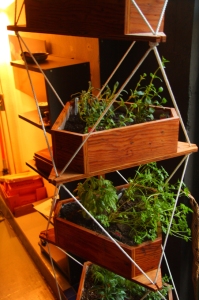 Visto
en / seen at: http://vertecology.com/?s=vertical
Visto
en / seen at: http://vertecology.com/?s=vertical
La jardinería colgante encuentra su máximo esplendor de las manos de Vertecology. Puedes tener una pequeña cosecha en tu casa, ahorrando espacio por su formato vertical, diáfano y cálido a la vez por el uso de sus materiales naturales.
The hanging gardening finds it's maximum highlight by the hands of Vertecology. You can have a small crop at home, saving space for it's vertical format, diaphanous and warm at the same time because of the use of natural materials.
Mini horta sustentável, visto en/ seen at: http://www.rosenbaum.com.br/blog/a-querida-horta-vertical/
Cosecha colgante / hanging crop. Visto en / seen at: http://myhangingbaskets.com/hanging_planters.htm
La misma idea de jardinería colgante puede usarse con las cosechas. Debido a la falta de espacio en las ciudades y si deseas tener un huerto urbano, puedes maximizar el espacio con esta útil idea de "hágalo usted mismo", colgando botellas recicladas para plantar dentro tomates u otros vegetales y ver cómo crecen boca abajo.
The same idea of hanging gardening can be used for the crops. Due to the lack of space in the cities and if you want to have a urban vegetable patch, you can maximize the space with this helpful DIY idea of hanging recycled bottles to plant inside tomatoes or other vegetables and see how they grow upside down.
Kokedama hanging plants / plantas colgantes Kokedama
El último jardín colgante que veremos hoy es el llamado Kokedama, una especie de trabajo de jardinería tradicional japonés en el que las plantas crecen en bolas de tierra y musgo, sin tiesto y pueden ser colgadas con cuerda de algodón o pita desde el techo. Los blogs Going Home to Roost y Design Sponge nos muestran unos hermosos tutoriales sobre cómo crear nuestro propio Kokedama.
The last hanging garden we will see today is the one called Kokedama, a kind of japanese traditional garden work in which plants do grow in balls of earth and moss, without planter, and they can be hanged by ropes form the ceiling. Going Home to Roost and Design Sponge blogs show beautiful tutorials about how to make our own kokedama garden.
Nancy Janes P1360 12-inch Stacking Planters / tiestos apilables
Available at/ disponible en: http://www.amazon.com/
Para finalizar, un especial macetero apilable en terrazas que puede ser también colgado. Tiene un sistema especial de riego para la correcta distribución del agua y la humedad.
To finalize, a special apilable terrace planter which can also be hanged. It has a special watering system for the correct water distribution and moisture.
© Desirée Gómez, 2013




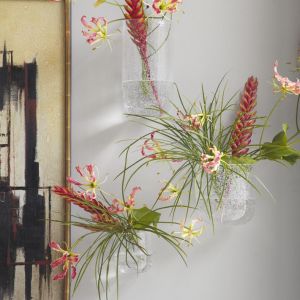








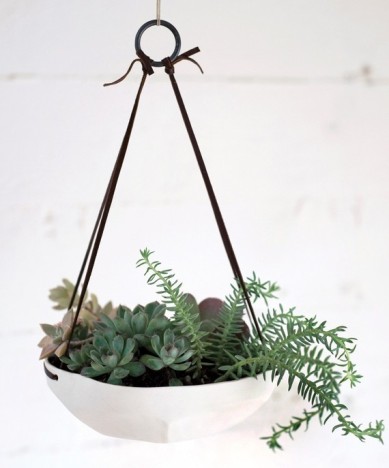
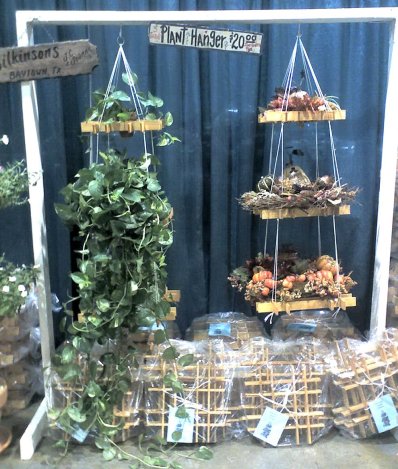
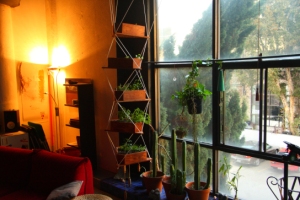
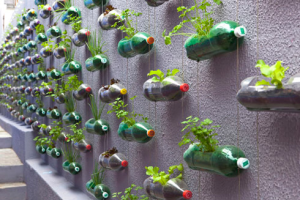

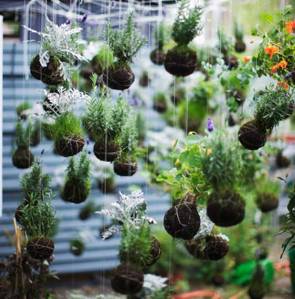
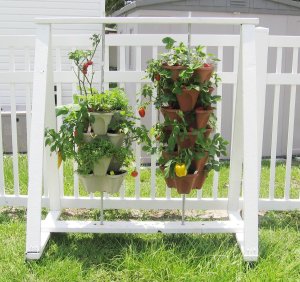
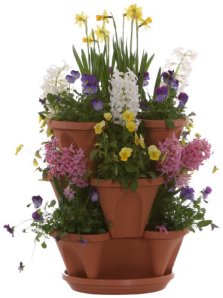

Escribir comentario